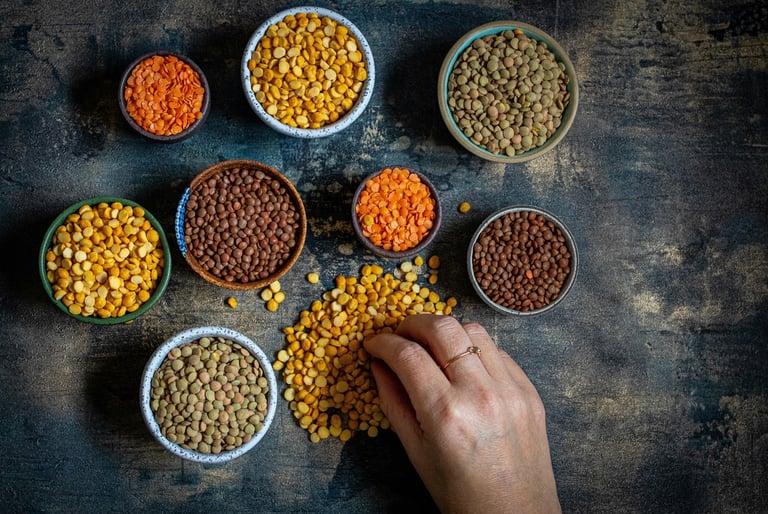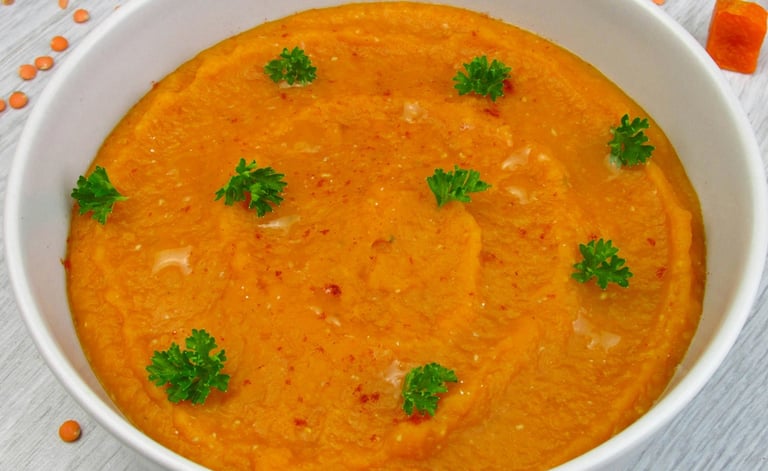
Plant-Based Proteins
The Future of Sustainable Eating
A Greener Plate, A Healthier Planet: Why the Shift to Plant-Based Proteins Matters
In recent years, a major shift has been taking place on dinner plates around the world. As more people grow conscious of both their personal health and the health of the planet, plant-based proteins are stepping into the spotlight. Whether it's due to ethical concerns, environmental awareness, or the desire to reduce chronic disease risk, this transition isn't just a trend—it's the future of food.
From humble lentils and chickpeas to tofu, tempeh, quinoa, and seitan, the plant kingdom offers a diverse and nutrient-dense range of protein sources. These foods aren't just meat alternatives; they're nutritional powerhouses in their own right, often boasting impressive fiber content, beneficial phytonutrients, and fewer saturated fats than animal products.
But there's more to this movement than just what’s on the plate. The environmental cost of animal agriculture is enormous, contributing significantly to greenhouse gas emissions, land degradation, and water use. In contrast, growing and consuming plant-based proteins requires fewer resources and has a far lighter carbon footprint.
In this article, we’ll break down:
What plant-based proteins are and where to find them
Their health benefits and nutritional profile
The environmental case for choosing plant-based
How to incorporate them into your everyday meals
Common myths and questions about protein adequacy
Whether you're plant-curious, fully vegan, or just looking to reduce your meat intake, understanding the value of plant-based proteins is a powerful step toward eating more sustainably—and deliciously.
What Are Plant-Based Proteins?
Plant-based proteins are protein sources that come exclusively from plants—no animal products involved. These include a wide variety of whole foods such as:
Legumes (lentils, chickpeas, black beans)
Whole grains (quinoa, farro, brown rice)
Soy products (tofu, tempeh, edamame)
Seeds and nuts (chia seeds, hemp hearts, almonds, peanuts)
Vegetables (broccoli, spinach, peas in modest amounts)
Unlike some animal proteins, plant proteins often come with added benefits like fiber, antioxidants, and lower saturated fat. And while some plant sources are not “complete” proteins (lacking one or more essential amino acids), eating a variety of them throughout the day easily provides the full amino acid profile your body needs.
Why People Are Choosing Plant-Based Proteins
1. Health Benefits
Switching to plant-based proteins may reduce your risk of:
Heart disease
Type 2 diabetes
Obesity
Certain cancers
Studies show that diets rich in legumes, whole grains, and soy can lower LDL cholesterol and help manage blood pressure. Additionally, fiber—a critical nutrient found in most plant proteins—is virtually absent in animal products but vital for gut health and satiety.
2. Environmental Sustainability
Animal agriculture accounts for:
14.5% of global greenhouse gas emissions
70% of agricultural land use
Significant deforestation and biodiversity loss
Plant-based protein production, by comparison, requires far less water, land, and energy. Lentils, for instance, produce up to 90% fewer emissions than beef. Eating plant-based even just a few times per week can contribute to a more sustainable food system.
3. Ethical Considerations
For many, the move toward plant-based eating is also rooted in concerns about animal welfare and industrial farming practices. Choosing plants over animals aligns with a compassionate, cruelty-free lifestyle for those who prioritize ethical sourcing.
Top Plant-Based Protein Sources to Know
Lentils
18g protein per cooked cup
High in iron, folate, and fiber
Versatile in soups, stews, curries, and salads
Tofu
10g protein per ½ cup
A complete protein
Absorbs flavor well and works in savory or sweet dishes
Quinoa
8g protein per cooked cup
Also a complete protein
A gluten-free whole grain rich in magnesium and B-vitamins
Chickpeas
15g protein per cooked cup
Also high in fiber
Used in hummus, curries, bowls, and snacks like roasted chickpeas
Tempeh
20g protein per ½ cup
Fermented and rich in probiotics
Nutty flavor and great for grilling, stir-fries, or sandwiches
Hemp Seeds
10g protein per 3 tablespoons
Rich in omega-3s
Perfect for smoothies, yogurt, or oatmeal toppings
Understanding Amino Acids: Complete vs. Incomplete Proteins
One of the most common concerns when adopting a plant-based diet is whether it provides all the essential amino acids your body needs. These are the building blocks of protein, and there are nine essential amino acids that your body can’t produce on its own—they must come from your diet.
Complete vs. Incomplete Proteins
A complete protein contains all nine essential amino acids in sufficient proportions.
Animal proteins (like meat, eggs, and dairy) are naturally complete.
Many plant proteins are incomplete, meaning they’re low in one or more essential amino acids.
For example:
Lentils are low in methionine.
Rice is low in lysine.
Chickpeas are low in methionine and cysteine.
The Myth of Protein Combining (And What’s True)
In the past, it was believed that you had to combine complementary plant proteins within the same meal—for instance, rice and beans—to create a complete amino acid profile. This idea led to complicated meal planning and unnecessary stress.
Good news: Modern nutrition science shows that your body can store amino acids for several hours (even days) and recombine them as needed—so long as you're eating a variety of plant-based protein sources throughout the day, you're covered.
Examples of Complementary Plant Proteins:


Key Takeaway:
You don’t need to overthink protein combining at every meal. Just focus on variety over the course of the day. Include different legumes, grains, nuts, and seeds, and your amino acid intake will naturally balance out.
How Plant Proteins Support Gut Health
One of the most underrated benefits of eating more plant-based proteins is their powerful effect on your gut health. Unlike animal proteins, which typically contain little to no fiber, plant proteins come naturally packaged with dietary fiber—especially soluble and insoluble fibers that feed and sustain the gut microbiome.
Fiber: The Fuel for Your Gut
Soluble fiber (found in lentils, beans, and oats) dissolves in water to form a gel-like substance that slows digestion and helps manage blood sugar. Insoluble fiber (found in whole grains, vegetables, and seeds) adds bulk to your stool and supports regular bowel movements.
Together, these fibers:
Help reduce constipation and bloating
Feed beneficial bacteria in the colon
Produce short-chain fatty acids (SCFAs) like butyrate, which reduce inflammation and strengthen the gut lining
SCFAs don’t just benefit the gut—they’re also linked to improved immune function, cardiovascular health, and even mood regulation.
Plant-Based Prebiotics & Fermentation
Many plant protein sources, especially legumes (like chickpeas and lentils), onions, garlic, and asparagus, contain prebiotics—specific types of fiber that selectively feed good gut bacteria such as Bifidobacteria and Lactobacillus.
Prebiotics help:
Increase microbial diversity in the gut
Improve mineral absorption (e.g., calcium and magnesium)
Enhance immune system performance
Additionally, fermented plant proteins like tempeh, miso, and natto are excellent sources of probiotics—live microorganisms that add directly to the population of healthy bacteria in your digestive system.
Gut Health and the Brain Connection
Emerging research points to the gut-brain axis, a communication network between your gastrointestinal system and central nervous system. A healthy, diverse microbiome has been linked to:
Reduced symptoms of anxiety and depression
Improved focus and cognitive function
Balanced production of neurotransmitters like serotonin (over 90% of which is made in the gut)
Eating plant-based proteins rich in fiber and prebiotics can therefore support not just digestion but also mental wellness, immune defense, and metabolic balance.
Environmental Case Study: Beef vs. Lentils
Here’s a quick side-by-side comparison of the environmental impact of 1 kilogram of protein from beef vs. lentils:


Source: Environmental Working Group, FAO
This stark contrast showcases why lentils and other legumes are key to sustainable food solutions.
Transitioning to Plant-Based Eating: Practical Tips
Shifting to a diet that includes more plant-based proteins doesn’t have to be an all-or-nothing change. In fact, the most sustainable dietary shifts are those made gradually, with enjoyment and flexibility in mind. Whether you're curious about going fully plant-based or just want to reduce your meat intake, these practical tips will help you ease into the lifestyle confidently.
1. Start with One Plant-Based Meal per Day
Begin by replacing just one meal a day with a plant-based option. Breakfast is often the easiest to start with.
Try options like:
Chia pudding with almond milk, fruit, and nuts
Overnight oats with hemp seeds and peanut butter
Tofu scramble with veggies, turmeric, and avocado toast
Smoothies with plant-based protein powder, spinach, banana, and flaxseeds
This simple shift builds momentum without disrupting your entire routine.
2. Embrace Meatless Mondays
Designating one day a week for plant-based meals—like Meatless Monday—is a great way to explore new recipes and create a regular habit.
You can:
Try lentil Bolognese over whole-grain pasta
Whip up chickpea curry with brown rice
Roast a tray of vegetables and serve with quinoa and tahini sauce
Make a big batch of black bean chili to enjoy for a few days
It’s also a fun opportunity to cook with friends or family and discover flavors you might have missed before.
3. Stock a Plant-Powered Pantry
Having a well-stocked pantry makes plant-based eating easier and faster to pull off on busy days.
Essentials to keep on hand:
Dry or canned beans: chickpeas, black beans, kidney beans
Lentils: green, red, brown—great for soups, stews, and curries
Whole grains: quinoa, brown rice, bulgur, oats
Nuts & seeds: chia, hemp, flax, almonds, sunflower seeds
Plant milks: unsweetened almond, oat, or soy milk
Spices: turmeric, cumin, smoked paprika, garlic powder, nutritional yeast
Canned tomatoes and coconut milk: perfect for sauces and curries
With just a few staples, you can create countless satisfying and high-protein meals.
4. Try Simple Plant-Based Swaps
Transitioning doesn't mean giving up your favorite meals—it means giving them a makeover.
Swap ideas:
Ground beef → Lentils or textured vegetable protein (TVP) in tacos, shepherd’s pie, or chili
Chicken stir-fry → Tofu or tempeh stir-fry with sesame sauce
Eggs → Chickpea flour omelets or scrambled tofu
Milk → Almond or oat milk in your coffee, cereal, or smoothies
Cheese → Nutritional yeast or cashew-based cheese sauces
These swaps retain the textures and flavors you love while boosting fiber and reducing saturated fat.
5. Explore Global Cuisines
Many cultures around the world have long traditions of plant-based cooking, offering endless flavor inspiration.
Some favorites to explore:
Indian cuisine: dal (lentil stew), chana masala, aloo gobi, vegetable biryani
Middle Eastern: hummus, falafel, mujadara (lentils and rice), tabbouleh
Ethiopian: misir wat (spicy lentils), shiro (chickpea stew), injera (teff-based flatbread)
Thai: green curry with tofu, veggie pad Thai, coconut-lentil soups
Latin American: black bean tacos, quinoa bowls, arepas with avocado and beans
Not only do these dishes deliver amazing flavor, but they also highlight how satisfying and culturally rich plant-based meals can be.
Common Concerns (And Reassurances)
Q: Can you build muscle on plant protein?
Yes. Many vegan athletes and bodybuilders thrive on plant-based diets using legumes, soy, and protein powders like pea or rice protein.
Q: Will I miss meat?
Flavor is often about seasoning and texture. With the right cooking techniques (like marinating tofu or roasting chickpeas), many people find plant-based meals deeply satisfying.
Q: What about soy and hormones?
Moderate soy consumption is safe and even beneficial. Myths about estrogen effects are largely debunked by current research.
The Future is Plant-Based
We are living through a pivotal shift in how the world eats. What was once seen as a niche lifestyle is now part of a global movement—driven by sustainability concerns, rising health awareness, food innovation, and ethical values. Plant-based proteins are no longer just an alternative; they’re becoming a cornerstone of how we’ll feed ourselves in a more conscious, responsible, and delicious way.
A Growing Global Demand
Across the globe, people are choosing plant-based more often—not just in response to environmental warnings, but because the food itself has evolved. Grocery shelves are now stocked with:
Plant-based meat alternatives made from pea or soy protein
Dairy-free yogurts, cheeses, and milks with impressive flavor and nutrition
High-protein snacks and powders sourced from rice, hemp, or chickpeas
Even fast-food chains and fine dining establishments are embracing the change, offering plant-forward menus to meet consumer demand. From flexitarians to full-time vegans, the accessibility of plant-based eating has never been greater.
Innovation at the Forefront
Food science and agri-tech are playing huge roles in making the plant-based future scalable and appealing:
Lab-grown (cultivated) meat is emerging as a viable way to provide animal protein without raising animals
Precision fermentation allows companies to recreate dairy proteins using microbes instead of cows
Vertical farming and regenerative agriculture are improving how we grow plants using fewer resources
These innovations aren’t just about replacing meat—they’re about reimagining food systems for a more sustainable, resilient future.
A Flexible, Inclusive Approach
Importantly, going plant-based doesn’t have to mean going 100%. The idea of perfection is outdated. What matters more is progress over purity. Even small changes—like choosing a lentil soup instead of beef stew once a week—have measurable impacts on:
Greenhouse gas emissions
Land and water use
Your personal health outcomes
This is the power of a flexitarian approach: it welcomes everyone into the solution, regardless of where they start.
Your Plate, Your Impact
Each plant-based meal is a vote—for a cleaner planet, for animal welfare, and for long-term health. And the beauty is that it’s also deeply enjoyable. From a spicy tofu stir-fry to a comforting bowl of dal, plant-based eating is rich in variety, flavor, and culture.
The future is not just plant-based—it’s inclusive, innovative, and empowering. Whether you’re experimenting with new recipes or fully transitioning your lifestyle, you’re part of a broader shift that’s shaping a better world.
References
Amino Acid Quality of Plant Proteins
Young, V. R., & Pellett, P. L. (1994). Plant proteins in relation to human protein and amino acid nutrition. The American Journal of Clinical Nutrition, 59(5), 1203S–1212S.
https://doi.org/10.1093/ajcn/59.5.1203S
Protein Adequacy on Plant-Based Diets
Mariotti, F., & Gardner, C. D. (2019). Dietary Protein and Amino Acids in Vegetarian Diets—A Review. Nutrients, 11(11), 2661.
https://doi.org/10.3390/nu11112661
Health Benefits of Plant-Based Diets
Satija, A., & Hu, F. B. (2018). Plant-based diets and cardiovascular health. Trends in Cardiovascular Medicine, 28(7), 437–441.
https://doi.org/10.1016/j.tcm.2018.02.004
Plant Proteins and Chronic Disease Risk
Li, S. S., et al. (2017). Plant-based (vegan) diets for cardiovascular disease prevention: All nutrients are not created equal. Current Atherosclerosis Reports, 19(12), 62.
https://doi.org/10.1007/s11883-017-0700-7
Environmental Impact of Protein Sources
Poore, J., & Nemecek, T. (2018). Reducing food’s environmental impacts through producers and consumers. Science, 360(6392), 987–992.
https://doi.org/10.1126/science.aaq0216
Life Cycle Assessment of Plant vs. Animal Protein
Clune, S., Crossin, E., & Verghese, K. (2017). Systematic review of greenhouse gas emissions for different fresh food categories. Journal of Cleaner Production, 140, 766–783.
https://doi.org/10.1016/j.jclepro.2016.04.082
Fermented Plant Foods and Gut Health
Marco, M. L., et al. (2017). Health benefits of fermented foods: microbiota and beyond. Current Opinion in Biotechnology, 44, 94–102.
https://doi.org/10.1016/j.copbio.2016.11.010
Fiber, Prebiotics, and the Gut Microbiome
Slavin, J. (2013). Fiber and Prebiotics: Mechanisms and Health Benefits. Nutrients, 5(4), 1417–1435.
https://doi.org/10.3390/nu5041417
Gut-Brain Axis and Plant-Based Diets
Mayer, E. A., et al. (2015). Gut Microbiota: A Potential Regulator of Neurodevelopment and Behavior. Neurogastroenterology & Motility, 27(4), 451–459.
https://doi.org/10.1111/nmo.12527
Plant-Based Diets and Global Food Systems
Willett, W., et al. (2019). Food in the Anthropocene: the EAT–Lancet Commission on healthy diets from sustainable food systems. The Lancet, 393(10170), 447–492.
https://doi.org/10.1016/S0140-6736(18)31788-4






